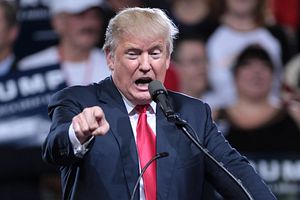U.S. President Donald Trump has upped the ante yet again in the trade war with China, announcing that his administration will move forward with tariffs on an additional $200 billion worth of Chinese imports. China has retaliated, and the new move seems to have scuttled the possibility of a new round of talks.
In a statement on September 17, Trump said he had “directed the United States Trade Representative (USTR) to proceed with placing additional tariffs on roughly $200 billion of imports from China.” The tariffs will start at 10 percent on September 24, before climbing to 25 percent on January 1, 2019.
The motivation for the tariffs is twofold. One, as with the first round of tariffs this summer on $50 billion of Chinese goods, Washington claims to be responding to “numerous unfair policies and practices relating to United States technology and intellectual property.” That includes requirements for U.S. companies to transfer technology to Chinese counterparts to access China’s market, as well as the theft of intellectual property. “These practices plainly constitute a grave threat to the long-term health and prosperity of the United States economy,” Trump said in the September 17 statement. Interestingly, the trade deficit – a favorite bugbear of Trump’s Twitter tirades – was not mentioned.
Second, however, the new round of tariffs is retaliation for China’s own retaliation. China responded in kind to the last round of U.S. tariffs, placing additional duties on $50 billion in U.S. imports ranging from agricultural goods to automobiles. While China’s response was entirely predictable, Trump responded angrily by threatening more tariffs – a threat he just made good on with the latest $200 billion announcement.
And based on Trump’s statement, the cycle will continue. “Further, if China takes retaliatory action against our farmers or other industries, we will immediately pursue phase three, which is tariffs on approximately $267 billion of additional imports,” Trump warned. Combined with the previous tariffs, that would mean tariffs on over $510 billion worth of goods — accounting for practically every Chinese product imported into the United States.
Despite Trump’s warning, China has already responded, promising tariffs of between 5 and 10 percent on $60 billion worth of U.S. imports. Beijing is no longer able to follow a tit-for-tat pattern in tariffs – there just aren’t enough U.S. imports to target. Last year, the United States only exported around $130 billion worth of goods to China.
Before Trump’s latest announcement, there had been rumors that the United States was seeking to invite Chinese officials to Washington for another round of talks. (The previous attempt, two days of talks held at the vice minister-level from August 22 to 23, made no progress.) But the new tariffs seem to have scuttled that invitation, with Chinese Foreign Ministry spokesperson Geng Shuang telling reporters on September 18 that “The latest steps taken by the U.S. has [sic] also brought new uncertainties to the consultations between our two sides.”
“[D]ialogue and consultation on the basis of equality, good faith, and mutual respect make the only viable way out for the China-U.S. trade issues. However, everything the U.S. does for now gives no impression of sincerity or goodwill,” Geng elaborated the next day. “…The U.S. side has kept talking up about dialogue and contact while wielding the big stick of sanctions. It sent the invitation for trade talks while imposing maximum pressure.”
Both the United States and China have insisted that their respective economies can weather the storm caused by the trade war – which means neither side is backing down. But the latest round of tariffs by both sides is likely to directly impact ordinary citizens.
U.S. consumers in particular could start seeing rising prices as the new tariffs impact a much broader swatch of imported goods. According to the New York Times, the public hearings held to evaluate the latest round of tariffs “were dominated by companies warning that the United States no longer had the capacity to produce replacement products for the Chinese imports that would be hit by tariffs.”
Meanwhile, China has already seen its stock market buffeted, with the Shanghai Composite Index falling by 16 percent from January to August 2018. Speaking at a World Economic Forum meeting in Tianjin, Chinese Premier Li Keqiang admitted that “China is confronted with a host of difficulties and challenges in economic development,” but insisted that China has “many tools in reserve … to manage difficulties and challenges.”

































